Emails are the letters of the modern-day world. You should know and understand what emails are exactly designed for. Otherwise, you keep getting burnt off it. Which means it’s time to ditch email communication.
I am sure that while handling projects, you must have witnessed that emails are not the ideal way to communicate and collaborate. In fact, it is the recipe for disaster.
Why? Because— emails are not designed for project collaboration and only support one-way communication.
Email communications are not productive, create confusion, are slow in nature and time-consuming, make it difficult to find information, and are inefficient for project collaboration.
According to a McKinsey report, the average professional spends 28% of the workweek reading and answering emails.
I used to struggle with email communication like you before switching to our project management and team collaboration tool, ProofHub. It has helped me to streamline projects, organize team communication, improve overall productivity, and make my life super easy.
But, the irony is instead of ditching email communication, a significant chunk still adheres to this outdated 21st-century AQL for project communication just because it is familiar.
Having a decade of experience as a CMO and using both emails and a project collaboration tool for project communication. I can provide you with a comparison based on my first-hand experience of why project managers need to ditch email communications for project management and should consider a switch to a project collaboration tool.
Switching from email to a project management tool is easy. Read to know more! Collaborate smarter: Move beyond email to a project management tool
7 Reasons project managers should ditch email communication for project collaboration
Emails and project communication is a bad idea. A project manager wants to make their life easy but email communication does the opposite.
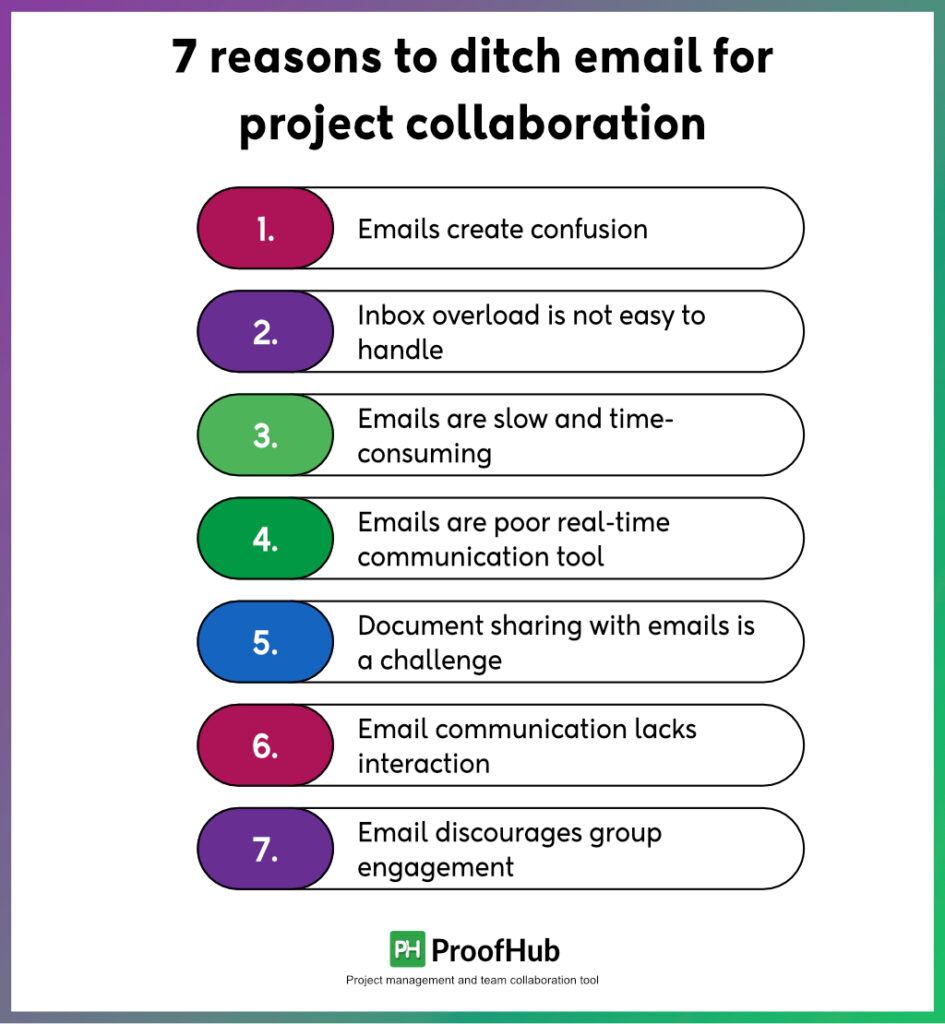
Here is why email makes life difficult for project managers and why you should consider ditching email communication:
1. Emails create confusion
Email is a good tool for one-way one-to-one or one-to-group communication, but not for two-way communication such as group discussions, brainstorming ideas, or assigning tasks.
The moment a few messages are exchanged between the team, team members ask queries, and clients request updates and changes, you will have a long email thread to deal with. You can easily get lost in a long threaded conversation.
The longer the conversation thread gets, the harder it will be to keep track of the conversation. Your entire communication can derail if you miss even one message.
2. Inbox overload is not easy to handle
An average employee receives 120 emails per day. Just think what would a project manager have to go through in their email inbox? There is a sea of emails to deal with.
Checking all the emails and replying to the emails can take a huge toll on your productivity and mental peace.
You might be secretly thinking “Stars” and “Labels” can solve the problem, but it does not. The moment you start working on complex projects or your team grows, it gets hard to organize the inbox and deal with emails pile-up using “Stars” and “Labels”.
Not just that the major problem with email is distractions. It does not allow you to focus on your tasks. Constant email notifications are a big sinkhole to your productivity.
3. Emails are slow and time-consuming
Drafting an email for every communication is a slow and time-consuming process. On top of that, you might have to wait for hours to get a reply. It is not an efficient tool for communication and wastes a lot of time.
Especially, if you are using emails for task delegation, it is not going to work. You need to draft an email for every task you assign, wait for confirmation from all the members that they understand everything, and then your task delegation is completed.
And if team members collaborating on a task ask for queries, you don’t know how many emails you need back and forth to get everyone on the same page.
Not to forget the clients’ requests for updates and changes.
Forget productivity. It’s going to be a mess that causes a lot of confusion, misunderstandings, and waste of time.
4. Emails are poor real-time communication tool
Email is an asynchronous communication solution. You do not expect someone to be available in the email inbox all the time. If you want to have a quick discussion with your teammate or want a project discussion with your team, email communication is a poor solution.
You do not know whether everyone is in communication or not. You do not know who has seen your message. Above all, you have to navigate through the long threads to keep track of the conversation.
It will take time to check all the messages and then write an email to reply. Thus, emails are not designed for real-time communication.
5. Document sharing with emails is a challenge
Project communication is not just about communication. You need to take into account document sharing, knowledge management, and online collaboration. Emails lack a centralized place for document organization and storage which makes it challenging to share, access, and store information. Also, emails pile up in the inbox making it difficult and time-consuming to retrieve information.
You might have a counter-argument with yourself, “I will use the advanced search filters to find files in the email inbox.”
But for long projects that run over the span of months, it is a horrendous experience to search for the files in the email inbox.
6. Email communication lacks interaction
Emails are designed for formal communication. We often do not use interactive features such as emojis, gifs, images, and informal tones in email conversations. This makes email communication boring.
Also, it is easy to misinterpret the message because emails lack nuances of tone. Especially when it comes to challenging discussions. You will end up creating unnecessary friction and miscommunication using emails for project communications.
7. Email discourages group engagement
Employee engagement is a hot topic of discussion in today’s times; especially for remote teams. Email does not offer you anything significant for employee engagement. You need an interactive space for group engagement activities such as the latest announcements, corporate news, upcoming events, surveys, or light-hearted discussions in which every member can participate.
The structure of the email is such that it does not encourage group participation. Long threads are not easy to navigate and writing emails is a time-consuming and laborious process. This discourages users from participating in group events.
I hope now you have some understanding of why emails are obsolete for project and team communication. Now, let’s find out what we can do to address these challenges and what solution we have.
Read more-: Best email productivity tools to transform inbox productivity
Switch from email communication to project collaboration tool
A significant share of project managers already moved from emails to a project collaboration tool for project communication.
A project collaboration tool is software that focuses on improving productivity, saving time, and making communication easy by streamlining your project communication and team collaboration — with a range of features including task management, real-time chat, task comments, centralized cloud file sharing, and project discussions.
Just to give you some idea, Project management and collaboration software help an average employee to save 498 hours per year.
I can tell you from my first-hand experience of using ProofHub for managing project communication of my entire marketing department for over a decade, it has improved my productivity too.
You can also transform your project communication and overcome the limitations of email communication by making a shift from email to a project collaboration tool.
Here is how a project collaboration tool transforms your project collaboration and team communication:
1. Eliminates confusion with centralized task delegation
The majority of the confusion in email communication is born during task delegation when there are a large number of tasks and team members ask questions for clarity in emails. It results in email-up and long threaded conversations which are difficult to navigate.
A project collaboration tool provides you with a centralized task management system to separate emails from task creation and delegation. You can add task details, set due dates, add assignees, attach files for references, & add other details required to complete a task and track all the tasks from a centralized task dashboard.
There is no need to draft emails to create and assign tasks. You can save plenty of time and reduce email overload in your inbox.
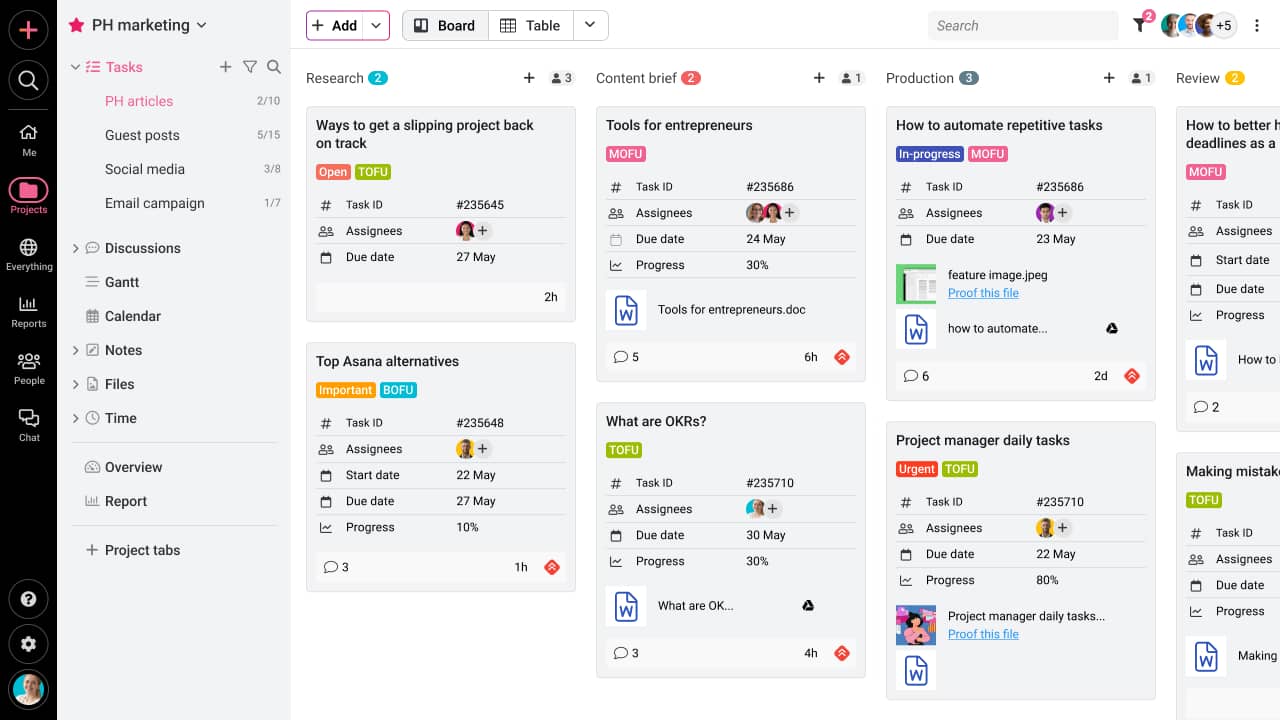
2. Create dedicated channels for communication
According to PMI, more than 30 percent of the time poor communication is the major reason for project failure.
You can create dedicated channels to streamline and organize your internal communication with a project collaboration tool. It helps you avoid confusion in your ongoing project communication. This eliminates the need for creating long back-and-forth emails and handling long conversation threads.
If anyone has queries, they can use the dedicated channels for communication.
For example, if anyone has project-related queries and wants to talk to you or any of the team members for clarity, they can have a quick one-on-one chat with you or participate in a group chat to find answers.
If you want an update on a task from your team member or want to gain the immediate attention of some team member on a task, you can use the task comments to tag the team member.
If you want to convey a message, you can create a dedicated space for project discussions to keep everyone on the same page. You can even add clients and other stakeholders in the project discussions to share updates.
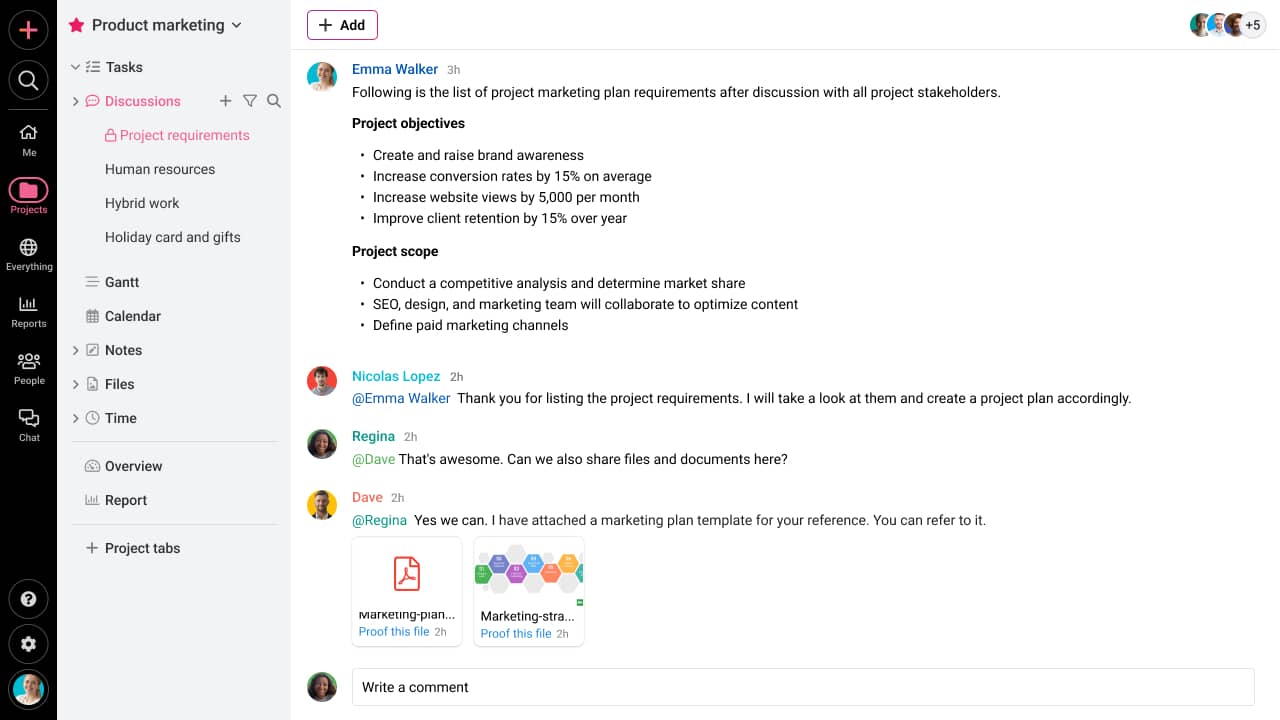
With dedicated communication channels, your entire project communication is streamlined. This avoids confusion, makes communication efficient, keeps everyone on the same page, reduces the risk of missing important information, increases transparency, and avoids accountability issues.
3. Central place for information sharing
Efficient project management tools provide you with a centralized platform for sharing digital assets. You can attach files to the tasks using cloud-based apps such as Google Drive, DropBox, and Onebox and from computers. This brings all your tasks related files to one place. You can retrieve the files anytime you need information.
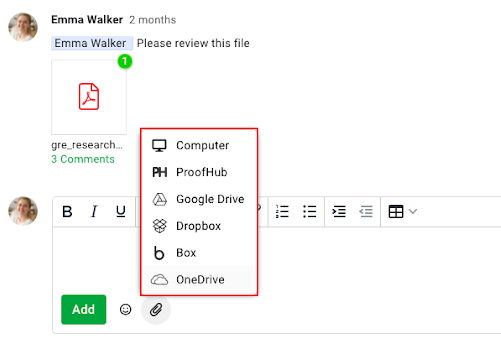
There is no need to search through a crowded inbox. You just take them out of the knowledge management and document-sharing process.
Imagine how much time it will save you and your team by having a dedicated and organized space for all the files. The saved time can be added to your productivity.
4. Communicate in real-time with your team
You can interact in real-time with your team using a project collaboration tool. For example, you can use real-time chat or start a group discussion to have a quick chat or group discussion. This makes it a breeze to communicate with your team members in real-time. There is no need to waste time and effort on creating emails and tracking conversations through long threads.
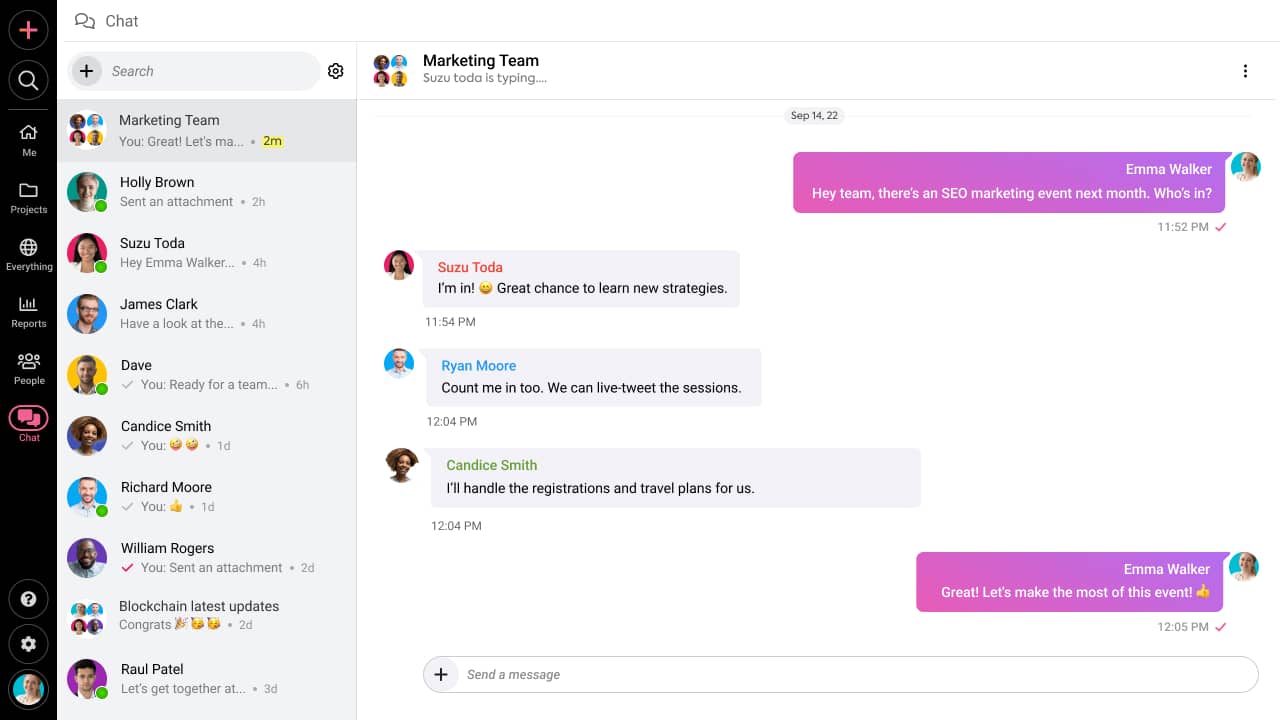
Also, you can use emojis, gifs, and other nuances of tones to make communication engaging. A project collaboration tool provides you with a user-friendly interface and a range of interactive features.
5. Boost team collaboration
Project collaboration tools help you boost team engagement by providing a platform for group communication. This platform allows you to share the latest updates, news, and announcements in a group and everyone can participate in the group discussion using emojis, gifs, and quick messages.
You can easily engage with your remote team and regularly run group activities without any hassle. Employee engagement keeps your team motivated and feels connected to the company which eventually encourages your team members to communicate without any barrier.
I hope now you are able to feel the difference a project collaboration tool can make in project and team communication.
Use these powerful team communication tools to collaborate effortlessly!
Importance of effective communication in project management
The purpose of communication in project management is to keep team members aligned so that the project can be completed on time with the desired quality. Correspondingly if you search for the reasons for project failure, you will find out unclear objectives, lack of transparency, and poor communication are the major ones.
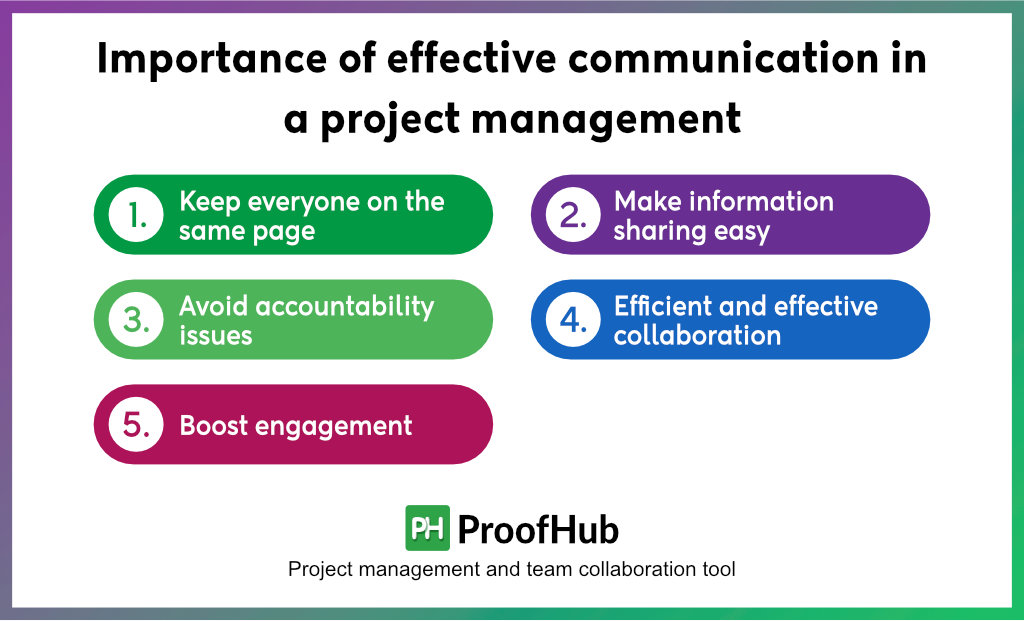
Effective project communication addresses all three to make your projects successful and offers a range of benefits. Have a look at what you will get with effective communication:
- Keep everyone on the same page: When everyone knows about the project goals & what is expected of them, and they have a primary method of communication, your entire team is aligned and have a clear understanding of project goals, objectives, and requirements. This helps you achieve project goals in time.
- Make information sharing easy: With dedicated channels for communication, your team knows where to look to gather primary project-related information, seek clarification, and raise concerns. This makes it easy to find information on projects when needed, share ideas, feedback, & updates, and promote teamwork.
- Avoid accountability issues: Effective communication brings transparency to your workflow. When you have dedicated channels to convey information, it eliminates the chances of missing information. You can monitor project communication to track project progress and address conflicts and issues. It also takes care of stakeholder engagement and makes sure they are engaged, informed, and involved throughout the project lifecycle.
- Efficient and effective collaboration: The right project collaboration tool provides you with a range of features to help you facilitate project communication, effectively share ideas, promote teamwork, and encourage participation. You waste less time on communication and become more productive and efficient.
- Boost engagement: Effective communication is not only subjected to project management. When you have a culture of communication, it seeps into organizational communication. It helps boost engagement which improves employee satisfaction.
Check out the importance ofeffective internal communication in project management
Check out the importance of effective internal communication in project management
The takeaway
Effective project communication is vital for the success of the project. And we have come to the conclusion, that emails are not designed for project communication. You can use it for individual communication, but not project communication.
To make your project communication effective, productive, and transparent, you have to begin somewhere. A project collaboration tool is a great way to revolutionize your project communication. It helps you effectively communicate with your team, improves productivity, reduces the time wasted due to inefficient communication, and makes life easy for you and your team.
Many have already switched and are enjoying all the benefits. You should enjoy these benefits too.
Ditch those messy emails and streamline your communication withProofHub.
FAQs about email communication
Why is email not an effective tool for team communication?
Email is not an effective tool for team communication because it is slow and time-consuming, lacks real-time interaction, leads to information overload, and lacks interactive features for engagement.
Why email communication is ineffective?
Email communication is ineffective because it causes information overload, creates confusion, lacks real-time interaction, and makes it difficult to find information through the email inbox.
What factors make email a difficult medium of communication?
You need to write long emails, messages can be easily misinterpreted, and email communication creates long threads. This wastes a lot of time and makes it difficult for team communication.

